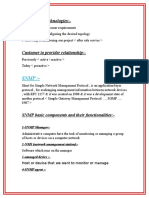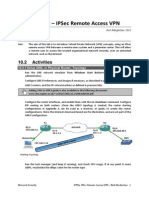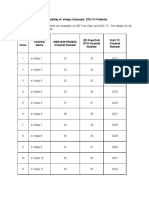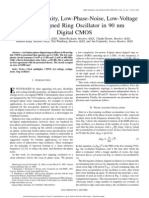Configuration Commands SNMP System Commands: Engineid
Configuration Commands SNMP System Commands: Engineid
Uploaded by
Lâu Huỳnh NgọcCopyright:
Available Formats
Configuration Commands SNMP System Commands: Engineid
Configuration Commands SNMP System Commands: Engineid
Uploaded by
Lâu Huỳnh NgọcOriginal Description:
Original Title
Copyright
Available Formats
Share this document
Did you find this document useful?
Is this content inappropriate?
Copyright:
Available Formats
Configuration Commands SNMP System Commands: Engineid
Configuration Commands SNMP System Commands: Engineid
Uploaded by
Lâu Huỳnh NgọcCopyright:
Available Formats
SNMP
Configuration Commands
SNMP System Commands
engineID
Syntax [no] engineID engine-id
Context config>system>snmp
Description This command sets the SNMP engineID to uniquely identify the SNMPv3 node. By default, the
engineID is generated using information from the system backplane.
If SNMP engine ID is changed in the config>system>snmp> engineID engine-id context, the current
configuration must be saved and a reboot must be executed. If not, the previously configured SNMP
communities and logger trap-target notify communities will not be valid for the new engine ID.
Note: In conformance with IETF standard RFC 2274, User-based Security Model (USM) for version
3 of the Simple Network Management Protocol (SNMPv3), hashing algorithms which generate
SNMPv3 MD5 or SHA security digest keys use the engineID. Changing the SNMP engineID
invalidates all SNMPv3 MD5 and SHA security digest keys and may render the node unmanageable.
When a chassis is replaced, use the engine ID of the first system and configure it in the new system to
preserve SNMPv3 security keys. This allows management stations to use their existing authentication
keys for the new system.
Ensure that the engine IDs are not used on multiple systems. A management domain can only have
one instance of each engineID.
The no form of the command reverts to the default setting.
Default The engine ID is system generated.
Parameters engine-id — An identifier from 10 to 64 hexadecimal digits (5 to 32 octet number), uniquely
identifying this SNMPv3 node. This string is used to access this node from a remote host with
SNMPv3.
7950 XRS System Management Guide Page 303
SNMP System Commands
general-port
Syntax general-port port-number
no general-port
Context config>system>snmp
Description This command configures the port number used by this node to receive SNMP request messages and
to send replies. Note that SNMP notifications generated by the agent are sent from the port specified
in the config>log>snmp-trap-group>trap-target CLI command.
The no form of the command reverts to the default value.
Default 161
Parameters port-number — The port number used to send SNMP traffic other than traps.
Values 1 — 65535 (decimal)
packet-size
Syntax packet-size bytes
no packet-size
Context config>system>snmp
Description This command configures the maximum SNMP packet size generated by this node. If the packet size
exceeds the MTU size of the egress interface the packet will be fragmented.
The no form of this command to revert to default.
Default 1500 bytes
Parameters bytes — The SNMP packet size in bytes.
Values 484 — 9216
snmp
Syntax snmp
Context config>system
Description This command creates the context to configure SNMP parameters.
Page 304 7950 XRS System Management Guide
SNMP
streaming
Syntax snmp
Context config>system>snmp>streaming
Description This command enables the proprietary SNMP request/response bundling and TCP-based transport
mechanism for optimizing network management of the router nodes. In higher latency networks,
synchronizing router MIBs from network management via streaming takes less time than
synchronizing via classic SNMP UDP requests. Streaming operates on TCP port 1491 and runs over
IPv4 or IPv6.
shutdown
Syntax [no] shutdown
Context config>system>snmp>streaming
Description This command administratively disables proprietary SNMP request/response bundling and TCP-
based transport mechanism for optimizing network management of the router nodes..
The no form of the command administratively re-enables SNMP request/response bundling and TCP-
based transport mechanism.
Default shutdown
shutdown
Syntax [no] shutdown
Context config>system>snmp
Description This command administratively disables SNMP agent operations. System management can then only
be performed using the command line interface (CLI). Shutting down SNMP does not remove or
change configuration parameters other than the administrative state. This command does not prevent
the agent from sending SNMP notifications to any configured SNMP trap destinations. SNMP trap
destinations are configured under the config>log>snmp-trap-group context.
This command is automatically invoked in the event of a reboot when the processing of the
configuration file fails to complete or when an SNMP persistent index file fails while the bof persist
on command is enabled.
The no form of the command administratively enables SNMP which is the default state.
Default no shutdown
7950 XRS System Management Guide Page 305
SNMP Security Commands
SNMP Security Commands
access group
Syntax [no] access group group-name security-model security-model security-level security-
level [context context-name [prefix-match]] [read view-name-1] [write view-name-2]
[notify view-name-3]
Context config>system>security>snmp
Description This command creates an association between a user group, a security model, and the views that the
user group can access. Access parameters must be configured unless security is limited to the
preconfigured access groups and views for SNMPv1 and SNMPv2. An access group is defined by a
unique combination of the group name, security model and security level.
Access groups are used by the usm-community command.
Access must be configured unless security is limited to SNMPv1/SNMPv2c with community strings
(see the community on page 308).
Default access group configurations cannot be modified or deleted.
To remove the user group with associated, security model(s), and security level(s), use:
no access group group-name
To remove a security model and security level combination from a group, use:
no access group group-name security-model {snmpv1 | snmpv2c | usm} security-level {no-auth-
no-privacy | auth-no-privacy | privacy}
Default none
Parameters group-name — Specify a unique group name up to 32 characters.
security-model {snmpv1 | snmpv2c | usm} — Specifies the security model required to access the
views configured in this node. A group can have multiple security models. For example, one
view may only require SNMPv1/ SNMPv2c access while another view may require USM
(SNMPv3) access rights.
security-level {no-auth-no-priv | auth-no-priv | privacy} — Specifies the required authentication
and privacy levels to access the views configured in this node.
security-level no-auth-no-privacy — Specifies that no authentication and no privacy (encryption) is
required. When configuring the user’s authentication, select the none option.
security-level auth-no-privacy — Specifies that authentication is required but privacy (encryption)
is not required. When this option is configured, both the group and the user must be configured
for authentication.
security-level privacy — Specifies that both authentication and privacy (encryption) is required.
When this option is configured, both the group and the user must be configured for
authentication. The user must also be configured for privacy.
context context-name — Specifies a set of SNMP objects that are associated with the context-name.
Page 306 7950 XRS System Management Guide
SNMP
The context-name is treated as either a full context-name string or a context name prefix
depending on the keyword specified (exact or prefix).
prefix-match — Specifies the context name prefix-match keywords, exact or prefix.
The VPRN context names begin with a vprn prefix. The numerical value is associated with the
service ID that the VPRN was created with and identifies the service in the service domain. For
example, when a new VPRN service is created such as config>service>vprn 2345 customer 1, a
VPRN with context name vprn2345 is created.
The exact keywork specifies that an exact match between the context name and the prefix value
is required. For example, when context vprn2345 exact is entered, matches for only vprn2345
are considered.
The prefix keyword specifies that only a match between the prefix and the starting portion of
context name is required. If only the prefix keyword is specified, simple wildcard processing is
used. For example, when context vprn prefix is entered, all vprn contexts are matched.
Default exact
read view-name — Specifies the keyword and variable of the view to read the MIB objects.
This command must be configured for each view to which the group has read access.
Default none
write view-name — Specifies the keyword and variable of the view to configure the contents of the
agent.
This command must be configured for each view to which the group has write access.
Values Up to 32 characters
notify view-name — specifies keyword and variable of the view to send a trap about MIB objects.
This command must be configured for each view to which the group has notify access.
Values none
attempts
Syntax attempts [count] [time minutes1] [lockout minutes2]
no attempts
Context config>system>security>snmp
Description This command configures a threshold value of unsuccessful SNMP connection attempts allowed in a
specified time frame. The command parameters are used to counter denial of service (DOS) attacks
through SNMP.
If the threshold is exceeded, the host is locked out for the lockout time period.
If multiple attempts commands are entered, each command overwrites the previously entered
command.
The no form of the command resets the parameters to the default values.
Default attempts 20 time 5 lockout 10 — 20 failed SNMP attempts allowed in a 5 minute period with a 10
minute lockout for the host if exceeded.
7950 XRS System Management Guide Page 307
SNMP Security Commands
Parameters count — The number unsuccessful SNMP attempts allowed for the specified time.
Default 20
Values 1 — 64
time minutes1 — The period of time, in minutes, that a specified number of unsuccessful attempts
can be made before the host is locked out.
Default 5
Values 0 — 60
lockout minutes2 — The lockout period in minutes where the host is not allowed to login.
When the host exceeds the attempted count times in the specified time, then that host is locked
out from any further login attempts for the configured time period.
Default 10
Values 0 — 1440
community
Syntax community community-string [hash | hash2] access-permissions [version SNMP-version]
[src-access-list list-name]
no community community-string [hash | hash2]
Context config>system>security>snmp
Description This command creates SNMP community strings for SNMPv1 and SNMPv2c access. This command
is used in combination with the predefined access groups and views. To create custom access groups
and views and associate them with SNMPv1 or SNMPv2c access use the usm-community
command.
When configured, community implies a security model for SNMPv1 and SNMPv2c only.
For SNMPv3 security, the access group command on page 306 must be configured.
The no form of the command removes a community string.
Default none
Parameters community-string — Configure the SNMPv1 and/or SNMPv2c community string.
Values community-string — 32 characters maximum
hash-key — 33 characters maximum
hash2-key — 96 characters maximum
hash | hash2 — Configures the hashing scheme for community-string. Hash specifies that the key is
entered in an encrypted form. If the hash parameter is not used, the key is assumed to be in a
non-encrypted, clear text form. For security, all keys are stored in encrypted form. Hash2
specifies that the key is entered in a more complex encrypted form.
access-permissions — Configures the access permissions for objects in the MIB.
r — Grants only read access to objects in the MIB, except security objects, using the internal
"snmp-ro" access group and the "no-security" snmp view.
Page 308 7950 XRS System Management Guide
SNMP
rw — Grants read and write access to all objects in the MIB, using the internal "snmp-rw" access
group and the "no-security" snmp view.
rwa — Grants read and write access to all objects in the MIB, including security, using the
internal "snmp-rwa" access group and the "iso" snmp view.
mgmt — Assigns a unique SMMP community string for SNMP access via the "management"
routing instance. This community uses the internal "snmp-mgmt" access group and the "mgmt"
snmp view.
vpls-mgmt — Assigns a unique SNMP community string for SNMP access via the "vpls-
management" routing instance. This community uses the internal "snmp-vpls-mgmt" access
group and "mgmt-view" snmp view.
version {v1 | v2c | both} — Configures the scope of the community string to be for SNMPv1,
SNMPv2c, or both SNMPv1 and SNMPv2c access.
Default both
list-name — Configures the community to reference a specific src-access-list, which will be used to
validate the source IP address of all received SNMP requests that use this community. Multiple
community, usm-community, or vprn snmp community instances can reference the same src-
access-list.
mask
Syntax mask mask-value [type {included | excluded} ]
no mask
Context config>system>security>snmp>view view-name
Description The mask value and the mask type, along with the oid-value configured in the view command,
determines the access of each sub-identifier of an object identifier (MIB subtree) in the view.
Each bit in the mask corresponds to a sub-identifier position. For example, the most significant bit for
the first sub-identifier, the next most significant bit for the second sub-identifier, and so on. If the bit
position on the sub-identifier is available, it can be included or excluded.
For example, the MIB subtree that represents MIB-II is 1.3.6.1.2.1. The mask that catches all
MIB-II would be 0xfc or 0b11111100.
Only a single mask may be configured per view and OID value combination. If more than one entry is
configured, each subsequent entry overwrites the previous entry.
Per RFC 2575, View-based Access Control Model (VACM) for the Simple Network Management
Protocol (SNMP), each MIB view is defined by two sets of view subtrees, the included view subtrees,
and the excluded view subtrees. Every such view subtree, both the included and the excluded ones,
are defined in this table. To determine if a particular object instance is in a particular MIB view,
compare the object instance’s object identifier (OID) with each of the MIB view’s active entries in
this table. If none match, then the object instance is not in the MIB view. If one or more match, then
the object instance is included in, or excluded from, the MIB view according to the value of
vacmViewTreeFamilyType in the entry whose value of vacmViewTreeFamilySubtree has the most
sub-identifiers.
7950 XRS System Management Guide Page 309
SNMP Security Commands
The no form of this command removes the mask from the configuration.
Default none
Parameters mask-value — The mask value associated with the OID value determines whether the sub-identifiers
are included or excluded from the view. (Default: all 1s)
The mask can be entered either:
• In hex. For example, 0xfc.
• In binary. For example, 0b11111100.
Note: If the number of bits in the bit mask is less than the number of sub-identifiers in the MIB
subtree, then the mask is extended with ones until the mask length matches the number of sub-
identifiers in the MIB subtree.
type {included | excluded} — Specifies whether to include or exclude MIB subtree objects.
included - All MIB subtree objects that are identified with a 1 in the mask are available in the
view. (Default: included).
excluded - All MIB subtree objects that are identified with a 1 in the mask are denied access in
the view. (Default: included).
Default included
snmp
Syntax snmp
Context config>system>security
Description This command creates the context to configure SNMPv1, SNMPv2, and SNMPv3 parameters.
src-access-list
Syntax src-access-list list-name
no src-access-list list-name
Context config>system>security>snmp
Description This command is used to identify a list of source IP addresses that can be used to validate SNMPv1
and SNMPv2c requests once the list is associated with one or more SNMPv1 and SNMPv2c
communities.
An src-address-list referenced by one or more community instances is used to verify the source IP
addresses of an SNMP request using the community regardless of which VPRN/VRF interface (or
‘Base’ interface) the request arrived on. For example, if an SNMP request arrives on an interface in
vprn 100 but the request is referencing a community, then the source IP address in the packet would
be validated against the src-address-list configured for the community. This occurs regardless of
whether the request is destined to a VPRN interface address and the VPRN has SNMP access
enabled, or the reques is destined to the base system address via GRT leaking. If the request’s source
Page 310 7950 XRS System Management Guide
SNMP
IP address does not match the ip-address of any of the src-hosts contained in the list, then the request
will be discarded and logged as an SNMP authentication failure.
Using src-access-list validation can have an impact on the time it takes for an SR OS node to reply to
an SNMP request. It is recommended to keep the lists short, including only the addresses that are
needed, and to place SNMP managers that send the highest volume of requests, such as the
5620 SAM, at the top of the list.
You can configure a maximum of 16 src-access-lists. Each src-access-list can contain a maximum of
16 src-hosts.
The no form of this command removes the named src-access-list. You cannot remove an src-access-
list that is referenced by one or more community instances.
Default none
Parameters list-name — Configures the name or key of the src-access-list. The list-name parameter must begin
with a letter (a-z or A-Z).
src-host
Syntax src-host host-name address ip-address
no src-host host-name
Context config>system>security>snmp>src-access-list
Description This command is used to configure a source IP address entry that can be used to validate SNMPv1
and SNMPv2c requests.
The no form of this command removes the specified entry.
Default none
Parameters host-name — Configures the name of the src-host entry.
ip-address — Configures an allowed source address for SNMP requests. This can be an IPv4 or IPv6
address.
Values ipv4-address a.b.c.d
ipv6-address x:x:x:x:x:x:x:x
x:x:x:x:x:x:d.d.d.d
x: [0..FFFF]H
d: [0..255]D
7950 XRS System Management Guide Page 311
SNMP Security Commands
usm-community
Syntax usm-community community-string group group-name [src-access-list list-name]
no usm-community community-string
Context config>system>security>snmp
Description This command is used to associate a community string with an SNMPv3 access group and its view.
The access granted with a community string is restricted to the scope of the configured group.
Alcatel-Lucent’s SR OS implementation of SNMP uses SNMPv3. In order to implement SNMPv1
and SNMPv2c configurations, several access groups are predefined. In order to implement SNMP
with security features (Version 3), security models, security levels, and USM communities must be
explicitly configured. Optionally, additional views which specify more specific OIDs (MIB objects in
the subtree) can be configured.
The no form of this command removes a community string.
Default none
Parameters community-string — Configures the SNMPv1/SNMPv2c community string to determine the
SNMPv3 access permissions to be used.
group — Specify the group that governs the access rights of this community string. This group must
be configured first in the config system security snmp access group context.
(Default: none)
list-name — Configures the usm-community to reference a specific src-access-list that will be used
to validate the source IP address of all received SNMP requests that use this usm-community.
Multiple community, usm-community, or vprn snmp community instances can reference the
same src-access-list.
view
Syntax view view-name subtree oid-value
no view view-name [subtree oid-value]
Context config>system>security>snmp
Description This command configures a view. Views control the accessibility of a MIB object within the
configured MIB view and subtree. Object identifiers (OIDs) uniquely identify MIB objects in the
subtree. OIDs are organized hierarchically with specific values assigned by different organizations.
Once the subtree (OID) is identified, a mask can be created to select the portions of the subtree to be
included or excluded for access using this particular view. See the mask command. The view(s)
configured with this command can subsequently be used in read, write, and notify commands which
are used to assign specific access group permissions to created views and assigned to particular
access groups.
Multiple subtrees can be added or removed from a view name to tailor a view to the requirements of
the user access group.
The no view view-name command removes a view and all subtrees.
Page 312 7950 XRS System Management Guide
SNMP
The no view view-name subtree oid-value removes a sub-tree from the view name.
Default No views are defined.
Parameters view-name — Enter a 1 to 32 character view name. (Default: none)
oid-value — The object identifier (OID) value for the view-name. This value, for example,
1.3.6.1.6.3.11.2.1, combined with the mask and include and exclude statements, configures the
access available in the view.
It is possible to have a view with different subtrees with their own masks and include and exclude
statements. This allows for customizing visibility and write capabilities to specific user
requirements.
7950 XRS System Management Guide Page 313
SNMP Security Commands
Page 314 7950 XRS System Management Guide
You might also like
- Snmp-Server Enable Traps: Notification-TypeDocument100 pagesSnmp-Server Enable Traps: Notification-TypeWagner HilarioNo ratings yet
- Nx-Os 6x SNMPDocument30 pagesNx-Os 6x SNMPAllan BrandNo ratings yet
- SNMP Over IPv6Document7 pagesSNMP Over IPv6Ryduano VicentNo ratings yet
- SNMP Cisco PDFDocument30 pagesSNMP Cisco PDFjjdegraciaNo ratings yet
- DLP 109 - Configure SNMP and Trap Management: PurposeDocument8 pagesDLP 109 - Configure SNMP and Trap Management: PurposeNetlabs IT SolutionsNo ratings yet
- 34 07 SNMP v3 ConfigurationDocument12 pages34 07 SNMP v3 ConfigurationmaurodiloretoNo ratings yet
- Cli SNMPDocument6 pagesCli SNMPnesco.alkes17No ratings yet
- CCNPv7 SWITCH Lab7-2 SNMP STUDENTDocument11 pagesCCNPv7 SWITCH Lab7-2 SNMP STUDENTMary Amirtha Sagayee. GNo ratings yet
- Maipu MannualDocument12 pagesMaipu MannualKazi BarakatNo ratings yet
- Visio-SNMP Cheat Sheet V1Document1 pageVisio-SNMP Cheat Sheet V1Walter ValverdeNo ratings yet
- 34 05 SNMP Simple Network Management ProtocolDocument8 pages34 05 SNMP Simple Network Management ProtocolmaurodiloretoNo ratings yet
- SNMP Cli Show Cli AlcatelDocument20 pagesSNMP Cli Show Cli Alcatelfalberto08No ratings yet
- Maipu MannualDocument12 pagesMaipu MannualHammad WarsiNo ratings yet
- SNMP Version 3 Tools Implementation GuideDocument64 pagesSNMP Version 3 Tools Implementation Guidejbhomie714No ratings yet
- Syslog SNMP Netflow ExplainingDocument8 pagesSyslog SNMP Netflow ExplainingOmarB.El-DeenNo ratings yet
- Solarwinds SNMPv2 and v3 Configuration GuideDocument7 pagesSolarwinds SNMPv2 and v3 Configuration Guide2629326No ratings yet
- Simple Network Management Protocol SNMP TutorialDocument4 pagesSimple Network Management Protocol SNMP TutorialmaguetteNo ratings yet
- SNMP V2Document2 pagesSNMP V2rahulpalhms27No ratings yet
- B UCSM GUI System Monitoring Guide 3 2 Chapter 01000Document8 pagesB UCSM GUI System Monitoring Guide 3 2 Chapter 01000yerocic586No ratings yet
- SNMPDocument22 pagesSNMPShawn PrafulNo ratings yet
- SNMPDocument12 pagesSNMPSSRK CREATIONNo ratings yet
- Lab 7-2 Configure Campus Network Devices To Support Simple Network Management Protocol (Snmpv3)Document14 pagesLab 7-2 Configure Campus Network Devices To Support Simple Network Management Protocol (Snmpv3)Haziq Akmal JubriNo ratings yet
- Ccnpv7.1 Switch Lab7-2 SNMP InstructorDocument29 pagesCcnpv7.1 Switch Lab7-2 SNMP InstructorSantiagoNo ratings yet
- 14.NTP Syslog SNMP NetflowDocument32 pages14.NTP Syslog SNMP Netflowanhtuan29No ratings yet
- Lab 10: Vpns - Ipsec Remote Access VPN: 10.1 DetailsDocument24 pagesLab 10: Vpns - Ipsec Remote Access VPN: 10.1 Detailscharles81No ratings yet
- HP Procurve Switch - Basic Configuration Guide IIDocument1 pageHP Procurve Switch - Basic Configuration Guide IIபாரதி ராஜாNo ratings yet
- Ccna Security Part 2cDocument29 pagesCcna Security Part 2cRatnesh KumarNo ratings yet
- Configure SNMPDocument14 pagesConfigure SNMPANGEL GuzmanNo ratings yet
- System Command Reference Generic Commands: ShutdownDocument114 pagesSystem Command Reference Generic Commands: Shutdownamir baroughNo ratings yet
- Configuring Security FeaturesDocument8 pagesConfiguring Security FeaturesedinNo ratings yet
- SNMP Exercises 1Document9 pagesSNMP Exercises 1ThanhNN0312No ratings yet
- Ruckus SNMP PDFDocument2 pagesRuckus SNMP PDFEgi Egi EgiNo ratings yet
- CPNR 9 1 Cli Ref GuideDocument245 pagesCPNR 9 1 Cli Ref GuidealexNo ratings yet
- Snmpv3: Feature SummaryDocument24 pagesSnmpv3: Feature SummarymadhumohanNo ratings yet
- MUICT SNMP v3Document82 pagesMUICT SNMP v3Eng PhichayutNo ratings yet
- Solarwinds SNMPv2 and v3 Configuration GuideDocument7 pagesSolarwinds SNMPv2 and v3 Configuration GuideSelma SbayouNo ratings yet
- Solarwinds Technical Reference: Implementing Snmpv3Document10 pagesSolarwinds Technical Reference: Implementing Snmpv3Camille Bertrand KiteNo ratings yet
- Lab 7.4.5 Configure SNMP Messages On A Cisco Router: ObjectiveDocument5 pagesLab 7.4.5 Configure SNMP Messages On A Cisco Router: Objectivearun0076@gmail.comNo ratings yet
- Cara Memanage Dlink 1510Document5 pagesCara Memanage Dlink 1510abdulhanan2010No ratings yet
- Configuring Snmpv3 On Huawei DevicesDocument3 pagesConfiguring Snmpv3 On Huawei DevicesHussein DhafanNo ratings yet
- SNMP Presents in Most of The Network Regardless of The Size of That NetworkDocument4 pagesSNMP Presents in Most of The Network Regardless of The Size of That Networkghada sayedNo ratings yet
- Command-Line Interface: Logging in To The NAMDocument4 pagesCommand-Line Interface: Logging in To The NAMXaoc KabataNo ratings yet
- 22 SNMP ConfigurationDocument17 pages22 SNMP ConfigurationXanNo ratings yet
- Simple Network Management Protocol-DD-WRTDocument8 pagesSimple Network Management Protocol-DD-WRTMarialis Vasquez JimenezNo ratings yet
- Cau Hinh SNMP CiscoDocument12 pagesCau Hinh SNMP Ciscothanhhai7No ratings yet
- NMT Assignment 1: Q1) A) Explain Two-Tier Network Management Organization ModelDocument12 pagesNMT Assignment 1: Q1) A) Explain Two-Tier Network Management Organization ModelTarun HarjaniNo ratings yet
- MiVoice MX-ONE SNMP ConfigurationDocument1 pageMiVoice MX-ONE SNMP ConfigurationEid CavalcantiNo ratings yet
- SNMP Agent: This Software Runs On The Hardware or Service BeingDocument3 pagesSNMP Agent: This Software Runs On The Hardware or Service BeingAhmedAbdelZaherNo ratings yet
- HP Networking Guide To Hardening Comware-Based DevicesDocument40 pagesHP Networking Guide To Hardening Comware-Based Devicesjc_fleuryNo ratings yet
- P2P L2 Asr9000Document88 pagesP2P L2 Asr9000ws_595No ratings yet
- CLI Temperatura y Cold Restart Ericsson TNDocument11 pagesCLI Temperatura y Cold Restart Ericsson TNandres1988maturin67% (9)
- NM SNMP Snmpv3Document10 pagesNM SNMP Snmpv3waseemNo ratings yet
- Assignment No 2 (End)Document8 pagesAssignment No 2 (End)Snehal FadaleNo ratings yet
- 01-16 Network Management and Monitoring CommandsDocument671 pages01-16 Network Management and Monitoring CommandsShubhang BhoiwarNo ratings yet
- System Administration Toolkit:: Using SNMP DataDocument10 pagesSystem Administration Toolkit:: Using SNMP DataFrance CalNo ratings yet
- An Express Guide SNMP For Secure Rremote Resource MonitoringDocument5 pagesAn Express Guide SNMP For Secure Rremote Resource MonitoringAbhishekKrNo ratings yet
- CISCO PACKET TRACER LABS: Best practice of configuring or troubleshooting NetworkFrom EverandCISCO PACKET TRACER LABS: Best practice of configuring or troubleshooting NetworkNo ratings yet
- LEARN MPLS FROM SCRATCH PART-B: A Beginners guide to next level of networkingFrom EverandLEARN MPLS FROM SCRATCH PART-B: A Beginners guide to next level of networkingNo ratings yet
- Configuration of a Simple Samba File Server, Quota and Schedule BackupFrom EverandConfiguration of a Simple Samba File Server, Quota and Schedule BackupNo ratings yet
- TL-WR941HP (Un) V2 UgDocument90 pagesTL-WR941HP (Un) V2 UgDaniel Veiga MarquesNo ratings yet
- Chapter 3. Transport LayerDocument70 pagesChapter 3. Transport Layerehddn0999No ratings yet
- Vidya Channel DetailsDocument3 pagesVidya Channel DetailsTechno HackerzNo ratings yet
- Self Initiated Sms/Mms Enabled Home Security System (Sisme-Hss)Document9 pagesSelf Initiated Sms/Mms Enabled Home Security System (Sisme-Hss)psatya432No ratings yet
- MRT99V59 MediaRing Talk User's Manual Version 6.5Document74 pagesMRT99V59 MediaRing Talk User's Manual Version 6.5nnNo ratings yet
- Best Internet Technology and ProviderDocument10 pagesBest Internet Technology and ProviderghazifreakNo ratings yet
- DSP For Explicit FEA AUC1999Document21 pagesDSP For Explicit FEA AUC1999jamelcharfiNo ratings yet
- 3600-4169 01 ModbusDocument26 pages3600-4169 01 ModbusSocaciu VioricaNo ratings yet
- Atmel 42566 ATWINC3400 WiFi BLE Network Controller Software Design Guide UserGuideDocument148 pagesAtmel 42566 ATWINC3400 WiFi BLE Network Controller Software Design Guide UserGuidestu807No ratings yet
- ResourceDocument30 pagesResource5n0wm4n504No ratings yet
- Presentation 11Document16 pagesPresentation 11agatha bacaniNo ratings yet
- SIP5 ComProt V9.70 Manual C055-J enDocument444 pagesSIP5 ComProt V9.70 Manual C055-J enrachaide.saidNo ratings yet
- Performance Requirements For GSM and UMTS Terminals v3 - 14Document141 pagesPerformance Requirements For GSM and UMTS Terminals v3 - 14azzgukNo ratings yet
- Open MPT CPR OuterDocument47 pagesOpen MPT CPR OuterezzsimoneNo ratings yet
- CDMA Drive Test and OptimizationDocument18 pagesCDMA Drive Test and OptimizationFikru0No ratings yet
- SAP Router Under Linux Environment RHEL5Document3 pagesSAP Router Under Linux Environment RHEL5gauravpanwar8No ratings yet
- User Manual For Web Server TrackingDocument8 pagesUser Manual For Web Server TrackingPablo GómezNo ratings yet
- Entuity White Paper SDNDocument7 pagesEntuity White Paper SDNfaisal MahmoodNo ratings yet
- dgx2 User GuideDocument125 pagesdgx2 User GuideAntoNo ratings yet
- Call Center Mock Calls Script Sample - TeDocument6 pagesCall Center Mock Calls Script Sample - TeAngelica TumampoNo ratings yet
- A Low-Complexity, Low-Phase-Noise, Low-Voltage Phase-Aligned Ring Oscillator in 90 NM Digital CMOSDocument8 pagesA Low-Complexity, Low-Phase-Noise, Low-Voltage Phase-Aligned Ring Oscillator in 90 NM Digital CMOSAndrew ChangNo ratings yet
- Spectrum BillDocument8 pagesSpectrum BillHARISH KUMAR100% (1)
- Design of Network Security Projects Using HoneypotDocument12 pagesDesign of Network Security Projects Using Honeypotyadidj100% (1)
- Data anh ThốngDocument99 pagesData anh ThốngThiện ĐứcNo ratings yet
- VSP1314 User ManualDocument74 pagesVSP1314 User ManualLuis Eduarte RomanNo ratings yet
- Bharat Heavy Electrical Haridwar: Submitted For Partial Fulfillment of Award of Bachelor of TechnologyDocument23 pagesBharat Heavy Electrical Haridwar: Submitted For Partial Fulfillment of Award of Bachelor of TechnologyMurali ShiramdasNo ratings yet
- Study of Emissions From Cell Towers On Temecula Valley Unified School District PropertyDocument18 pagesStudy of Emissions From Cell Towers On Temecula Valley Unified School District PropertyThe Press-Enterprise / pressenterprise.comNo ratings yet
- 11508r01ONVIF Members-OnVIF PTZ Test Specification v1.02.4Document81 pages11508r01ONVIF Members-OnVIF PTZ Test Specification v1.02.4Jose Roberto Barrios RochaNo ratings yet
- Frequency ModulationDocument26 pagesFrequency ModulationYunita FtrynNo ratings yet
- Building Advanced Metering Infrastructure Using Elasticsearch Database and IEC 62056-21 ProtocolDocument7 pagesBuilding Advanced Metering Infrastructure Using Elasticsearch Database and IEC 62056-21 Protocolagus wiyonoNo ratings yet

























































































